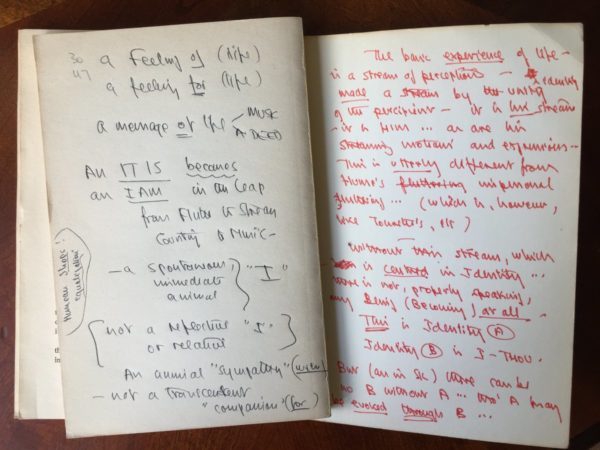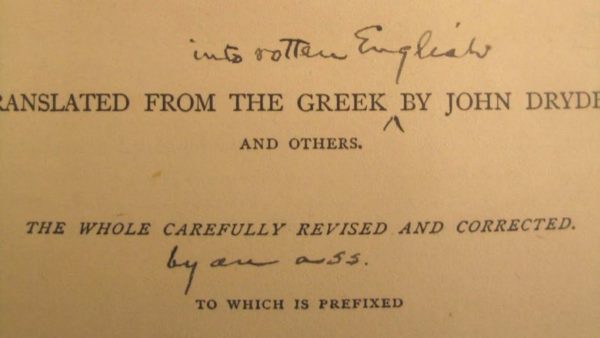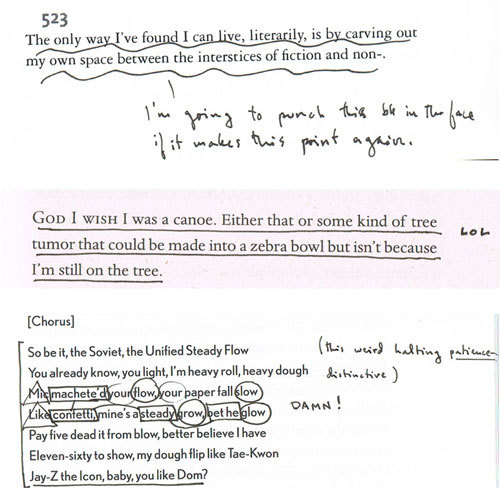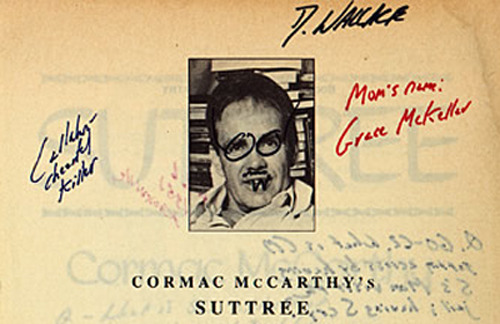Reading with a pencil in hand
- Transfer

An intellectual is simply a person who has a pencil in his hands while reading a book.
- George Steiner
Photographer Bill Hayes wrote an interesting story about Oliver Sachs ' love for words, and tweeted photos of books where Sachs made notes:

Saks " adored taking notes on the pages of books that he read - thoughts, ideas, arguments in a dispute with the author, diagrams." Probably, it was very interesting to leaf through such a library (more than 500 books) and to see Sachs undisguised thoughts in the fields and on the last pages:

Such is the ancient practice, called marginals . It seems to me that the first step in becoming a writer is to become a reader, and the second is to become a reader with a pencil. When you emphasize, circle and write down questions, and argue on the margins, you exist in that interesting intermediate world between the reader and the writer:

Patricia Lockwood wrote about it like this:
There is a way to read, similar to writing. You feel that you are working together. You have a pen in your hands, you go hand in hand, and half turn into a creator. You draw out useful moments for yourself, sift the text in search of gold.
To wash gold, or “to seek images,” as Alain Ginsberg calls it in the poem “ Supermarket in California .”

A copy of Plutarch's book " Comparative biographies ", which belonged to Mark Twain.
Sometimes the marginal notes are a little inferior to giving the author in the face . I really like Sam Anderson’s “ Year of Marginal Notes ” article , where he publishes photos of his notes :

Most of all I like to write in the fields: spontaneous breakthroughs of pure and personal reactions to the book that is in front of me. This is the most personal, complete and honest form of criticism possible - not a big, wide-angle shot from an airplane, which you get from the official review, but records from one moment to another, showing how you actually perceive the book that is actively reading the brain.
Whether you are washing gold, or throwing feces into the dead, field notes turn reading into writing. My friend John Unger once told me: “I did all the works of art because I saw something bad, and I thought I could do better, or I saw something great, and I wanted to catch up with it.”

Notes by Francis Ford Coppola on the book "The Godfather" by Mario Puzo
In Sam Anderson’s article “ I really want someone to lie in the text, ” he points out that the marginal notes used to be part of social communication:
People marked books for each other as gifts, or gave markedly marked novels to potential lovers. Samuel Taylor Coleridge, the undisputed champion of field notes of all time, succeeded at the end of this historical period, and his friends always begged him to mark up books for them. He eventually published some of his notes in the margins, and in the process even popularized the word marginalia - pompous Latinism, mocking the triviality of form.
I have books marked up by my father-in-law and my wife when they were in high school. Their reading is like a journey through time — I can visit them in the past. Sometimes I imagine my children reading one of my books and stumble upon my note.

My notes in Maggie Nelson’s book “The Argonauts”
I like the idea of field notes as a way to turn a book into a place to talk - a literary exchange of notes. Gilbert Keith Chesterton once walked through his friend’s just-published book of aphorisms and wrote an answer for each one in pencil (later his notes were published under the name Platitudes Undone ). Sam Anderson and David Rees wrote each other notesin a copy of Dan Brown’s Inferno. J.J. Abrams and Doug Dorst used handwritten notes as one of the plot moves in their novel " Theseus Ship " (I really enjoyed watching the readers share their margin notes in my book Show Your Work!).

A copy of Kormak McCarthy's semi-autobiographical novel Suttree, owned by David Foster Wallace.
Finally, margin notes are a way to truly own your books and your own reading. This is what Mortimer Adler and Charles van Doren wrote in their classic book How to Read a Book :
You will fully master the book only when you make it a part of yourself, and the best way to do it is to write in it. Why are the entries in the book inseparable from reading? First, it keeps your mind active. Secondly, active reading is thinking, and thinking usually expresses itself in words spoken or written. If a person says that he knows what he is thinking, but cannot express it, he usually does not know what he is thinking. Third, recording your reaction helps you remember the thoughts of the author. Reading a book should be a conversation between you and the author. Marking in the book is an expression of the divergence of your opinions. This is the highest respect you can show him.
Read with a pencil!
